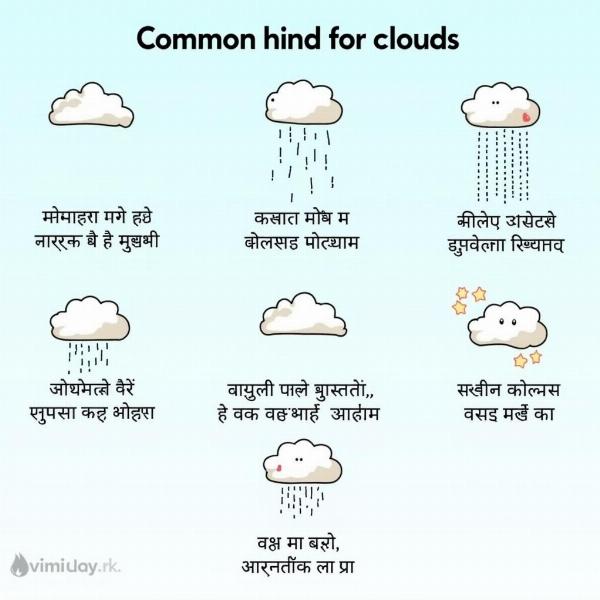Understanding the meaning of “clouds” in Hindi goes beyond a simple translation. It delves into cultural nuances, literary symbolism, and even meteorological understanding. This article explores the various Hindi words for “clouds,” their contextual usage, and their significance in Indian culture. We’ll also discuss common phrases and idioms related to clouds, providing a richer understanding of this everyday yet profound natural phenomenon.
Different Words for “Clouds” in Hindi
The most common Hindi word for “cloud” is बादल (badal). This term is widely understood and used across various regions of India. However, the richness of the Hindi language offers several other words that describe clouds with more specific characteristics. For example, मेघ (megh), often used in poetry and literature, evokes a sense of grandeur and power. घन (ghan) implies dark, rain-bearing clouds, while जलद (jalad) specifically refers to clouds carrying water. Understanding these nuances adds depth to your understanding of Hindi and Indian culture.
Clouds in Indian Culture and Mythology
Clouds hold a significant place in Indian mythology and folklore. They are often associated with deities like Indra, the god of rain and thunder. In ancient texts, clouds are depicted as celestial chariots carrying the gods. They are also seen as symbols of abundance, prosperity, and life-giving force. This cultural reverence for clouds reflects their importance in the predominantly agricultural Indian society.
Common Phrases and Idioms Related to Clouds
The Hindi language is replete with idioms and phrases that use clouds as metaphors. For example, “सिर पर बादल मंडराना” (sir par badal mandrana) translates to “clouds hovering over the head,” indicating impending doom or trouble. Similarly, “नौ दो ग्यारह होना” (nau do gyarah hona), which literally means “nine two eleven,” describes someone disappearing quickly, like clouds scattering in the wind. These expressions vividly illustrate how clouds are woven into everyday language and cultural understanding.
 Hindi Idioms Related to Clouds
Hindi Idioms Related to Clouds
Clouds and Weather Forecasting in India
Traditionally, farmers in India relied on observing cloud formations to predict weather patterns. The appearance of dark, heavy clouds (घन – ghan) signaled the arrival of monsoon rains, crucial for agriculture. Even today, this traditional knowledge plays a role in local weather forecasting, supplementing modern meteorological techniques.
The Poetic Significance of Clouds
Clouds have been a source of inspiration for poets and artists throughout history. In Hindi literature, clouds are often used as metaphors for emotions, dreams, and the ephemeral nature of life. Their changing forms and ethereal beauty lend themselves to evocative imagery and symbolism.
What does “Badal Garajna” mean?
Badal Garajna (बादल गरजना) means the rumbling or roaring of clouds, often indicating an approaching thunderstorm.
How do you say “dark clouds” in Hindi?
“Dark clouds” in Hindi can be translated as काले बादल (kale badal) or घनघोर बादल (ghanghor badal). The latter emphasizes the thickness and darkness of the clouds.
Conclusion
The meaning of “clouds” in Hindi is multifaceted, encompassing scientific, cultural, and literary dimensions. From the simple बादल (badal) to the more evocative मेघ (megh), each term offers a unique perspective on this natural wonder. Understanding the various words for clouds, their associated idioms, and their significance in Indian culture provides a deeper appreciation for the language and the world around us. By exploring these nuances, we gain a richer understanding of the interplay between language, nature, and culture.
FAQs
-
What is the most common word for “clouds” in Hindi? The most common word is बादल (badal).
-
What does मेघ (megh) signify? मेघ (megh) is often used in poetry and carries a sense of grandeur.
-
What Hindi word implies rain-bearing clouds? घन (ghan) refers to dark, rain-bearing clouds.
-
How are clouds viewed in Indian culture? Clouds are often associated with deities and symbolize abundance and prosperity.
-
Can you give an example of a Hindi idiom related to clouds? “सिर पर बादल मंडराना” (sir par badal mandrana) means “clouds hovering over the head,” indicating impending trouble.
-
What is the significance of clouds in Hindi poetry? Clouds are often used as metaphors for emotions, dreams, and the ephemeral nature of life.
-
How was traditional weather forecasting done in India using clouds? Farmers observed cloud formations to predict weather patterns, especially the arrival of monsoon rains.
Related Articles
Meaning-Hindi.in is your premier destination for professional Hindi translation services, specializing in business, legal, technical, website localization, educational, and urgent translation needs. We provide accurate and culturally sensitive translations that bridge language barriers and facilitate effective communication. Our team of expert linguists ensures quality and timely delivery for all your translation projects. Contact us today for a free quote! Email: [email protected], Phone: +91 11-4502-7584. Discover the power of seamless communication with Meaning-Hindi.in.